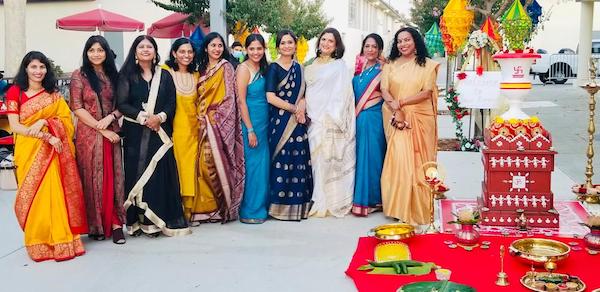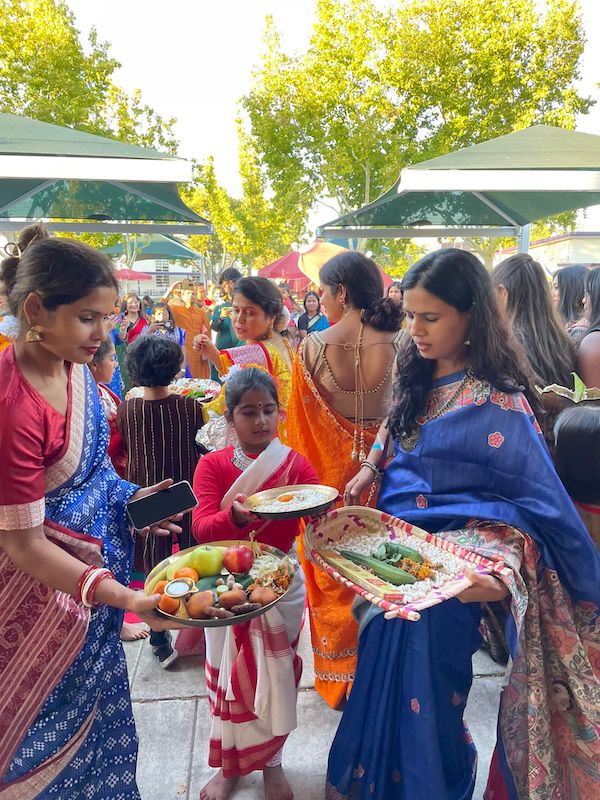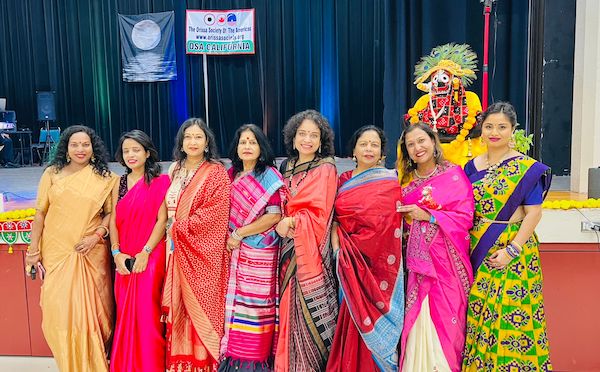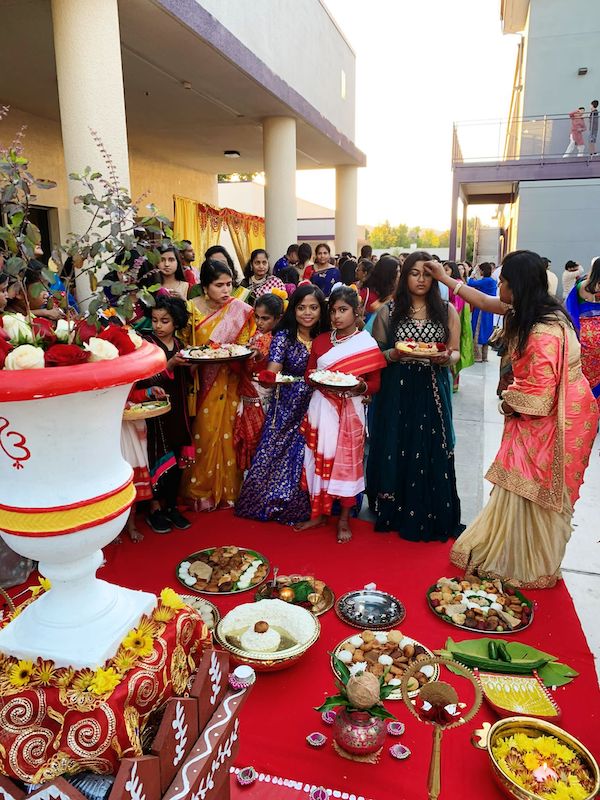Maidens of the Moon: The Joyous Celebration of Kumara Purnima Kindles Memories of Home
- The Odia festival was celebrated on Oct. 9th at the Amador Valley High School auditorium in Dublin, Calif.

Kumara Purnima is one of the most celebrated women’s festivals in Odisha. The word ‘Kumara’ literally means unwed, and Purnima means the full moon. It compares maidens to the full moon. Young women are celebrated in this festival. It falls on the fifth day after the Durga Puja Dasami on the first full moon day of September/ October, according to the lunar calendar. The moon symbolizes feminine power, prosperity, serenity, and beauty in its imperfection.

The imperfectness of the moon has always intrigued me. My mother used to say that even the beautiful moon has blemishes marking the dark spots amid brightness. Chanda (moon) is worshiped on this day, also known as Chanda puja (moon worship). It is believed that on this day, as the moon and the earth are very close, the moon’s rays have specific healing properties that nourish the body and the soul.
Besides the moon, this day also celebrates Gaja Lakshmi (goddess of wealth and good fortune on an elephant) and the God Kartikeya (the handsome son of Parvati and Siva). Girls in the villages get together and spend the day leisurely eating good food, wearing new clothes, and seeking good fortune from the moon. This autumn festival brings joy, happiness, and a sense of community among the girls.

When Odias transplanted themselves from India to North America, they brought some of their feasts and festivals to sustain themselves. They are the people of Odisha, a state of over 45 million people in southeastern India. Most Odias in the Bay Area are predominantly from Cuttack and Bhubaneswar, the former and present capital respectively, as well as the seat of premier educational institutions of the state.
About 500 people participated in the fun event this year. It was organized by the Odisha Society of the Americas (OSA) California chapter.
OSA is a socio-cultural organization of the Odias living in North America and has been growing since its inception in 1968. The place was full of colors reflected in the beautiful saris and other traditional costumes of girls and women. There were fun-filled activities for the young and old. The children participated in competitions like art, dance, music, singing, and the kauri game. A typical Odia sport, Pucchi, was introduced.
“Even though we have transplanted ourselves from our homeland in Odisha, we have preserved our culture and tradition by following these celebrations. We have traditionally performed this ritual using conch cells, flowers, and lamps.”
Participating in these activities transported me back to memory lane when I played thia pucchi (swirling the body in a standing position) and basa Pucchi (a squatting game). I vividly remember playing these two games under a full moonlit sky. The adults entertained themselves by playing card games like 29 and socializing. Even though this celebration was primarily for women, the whole family came to participate in it.
Kumara Purnima celebration in Dublin was a recreation of the festival of Odisha. The food, décor, and ambiance on this occasion were extraordinary.
The spectacular sight was a beautifully decorated Tulasi plant in front of the auditorium. A variety of homemade cakes, a moon made with homemade cheese, Khai (fried paddy) and molasses, all kinds of fruits, and sweet dishes were offered for the Chanda puja (worship of the full moon). About 140 girls came prepared with their thalis (flowers and sweets) and worshipped the moon. Dr. Anjalika Pattanaik, one of the founding members of this community, said, “even though we have transplanted ourselves from our homeland in Odisha, we have preserved our culture and tradition by following these celebrations. We have traditionally performed this ritual using conch cells, flowers, and lamps”. She was delighted.
My earliest memory of celebrating Kumara Purnima takes me back to Cuttack, where I spent my childhood, adolescence, and early adult life. It is known as the most important festival immediately after Dussehra, the culmination of mother Durga. But unlike the grandeur of Durga puja — a public display of wealth and grandeur, lights, and massive crowds — Kumara Purnima is much more personal, community-based, and meant for celebrating young women.

For me, Kumar Purnima was a special occasion, and I looked forward to wearing new clothes, eating delicious food, and in the evening, worshipping the full moon in front of the Tulasi plant, the ubiquitous feature of every Odia household. I always looked forward to my mother’s delicacies. I remember the care she took to make the Kumara Purnima ritual so beautiful. She was not into any strict dos-and-don’ts, but made the day full of fun and feasts – delicious homemade Kakaras and mandas. Of course, kheer would be a must.
The Tulasi plant at the Kumara Purnima festival in Dublin reminded me of my childhood. Tulasi chaura (the pandal) is meaningful in my life. I wondered about the power and glory of the Tulasi plant. My mother worshipped the plant every day. Early morning after a bath, and a change into a fresh sari, she would light a ghee lamp in front of the Tulasi pandal in our courtyard before going to her puja room for her daily ritual. The evening will be marked by lighting a lamp and burning incense sticks at the chaura. I was barely three years old when our house was built. My mother had insisted on having a Tulasi chaura. She explained that Tulasi is the consort of Vishnu, very kind and giving (also known as a medicinal plant). She would make sure to appease the consort before attending to Vishnu. From a very early age, I realized nature’s and humanity’s interconnectedness.

As I recall from my memories of this celebration, despite being a women-centric festival, both men and women participated. I remember men in our neighborhood collected flowers for the Puja. Early morning, I saw young men dive deep into the neighborhood pond for pink and white-water lilies. They would drop off some for me at my mother’s request and take the rest for their sisters.
Fast forward to 2022. I lived in the U.S. for more than three decades and have never had the opportunity to celebrate this festival. We have moved on without too many feasts and festivals in our busy work-filled life.
This year the Odia community revived the ritual with this beautiful celebration of Kumara Purnima. This was the first in-person community event after the traumatic pandemic of the last two years. The people were excited, and young children were inspired by their parents and community to showcase their talent. This festival that brought 500 people together should serve as a reminder that amid uncertainties, it is time to be aware of our interconnectedness with celestial beings. For the children, it is not only a joyous occasion to enjoy the festivities but also an opportunity to participate in community events, make new friends, and affirm a sense of belonging to their community. These children who grow up in America will share a sense of pride in their heritage.
Annapurna Devi Pandey teaches Cultural Anthropology at the University of California, Santa Cruz. She holds a Ph.D. in sociology from Jawaharlal Nehru University, New Delhi, and was a postdoctoral fellow in social anthropology at Cambridge University, the U.K. Her current research interests include diaspora studies, South Asian religions, and immigrant women’s identity-making in the diaspora in California. In 2017-18 she received a Fulbright scholarship for fieldwork in India. Dr. Pandey is also an accomplished documentary filmmaker. Her 2018 award-winning documentary “Road to Zuni,” dealt with the importance of oral traditions among Native Americans.



Very informative and useful write up. Delighted to know about the feelings of the Odia ‘s in USA and South Africa. Thanks to everyone for their feelings towards the Odia culture and tradition. In my opinion they are following the rituals more than us here. Once again thanks to everyone